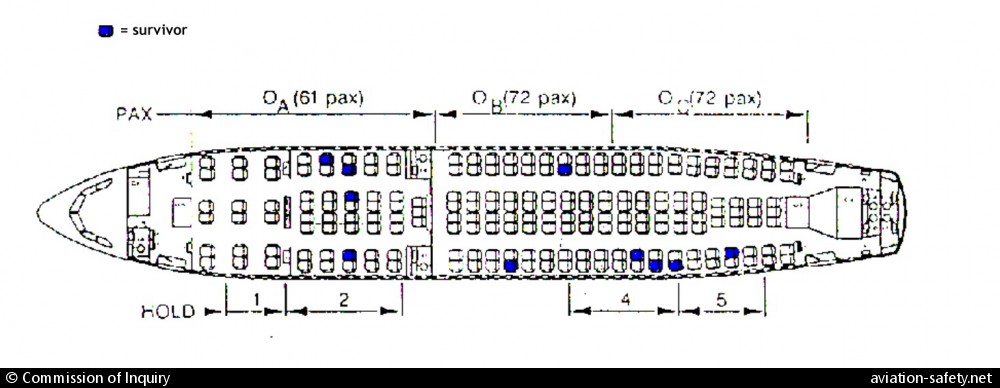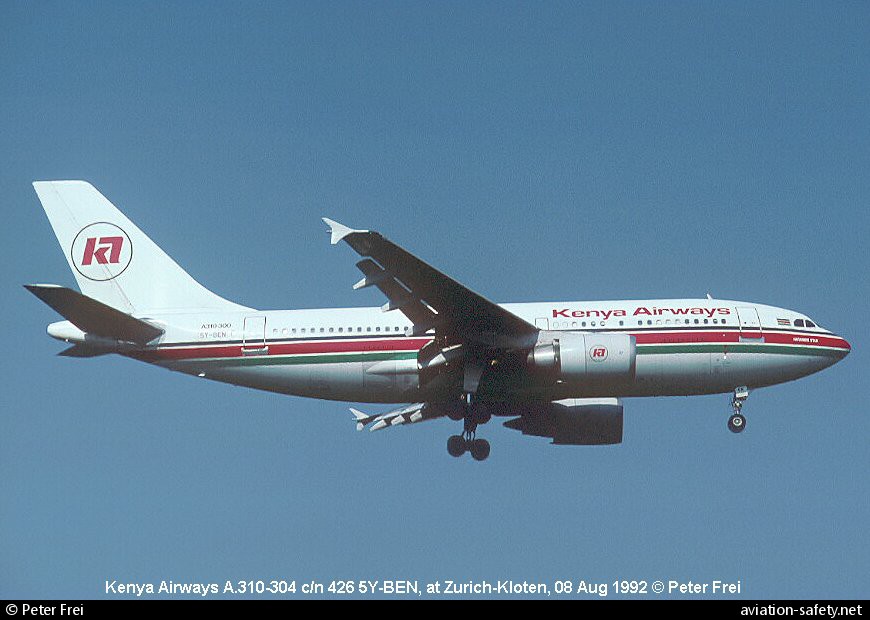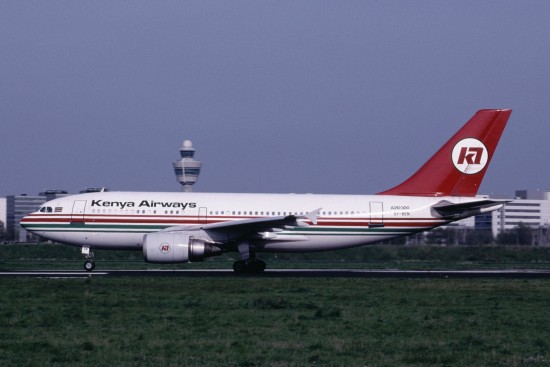
| Date: | Sunday 30 January 2000 |
| Time: | 21:09 |
| Type: |  Airbus A310-304 |
| Owner/operator: | Kenya Airways |
| Registration: | 5Y-BEN |
| MSN: | 426 |
| Year of manufacture: | 1986 |
| Total airframe hrs: | 58115 hours |
| Cycles: | 15026 flights |
| Engine model: | General Electric CF6-80C2A2 |
| Fatalities: | Fatalities: 169 / Occupants: 179 |
| Aircraft damage: | Destroyed, written off |
| Category: | Accident |
| Location: | 2,8 km S off Abidjan-Felix Houphouet Boigny Airport (ABJ) -
 Cote d'Ivoire Cote d'Ivoire
|
| Phase: | En route |
| Nature: | Passenger - Scheduled |
| Departure airport: | Abidjan-Felix Houphouet Boigny Airport (ABJ/DIAP) |
| Lagos-Murtala Muhammed International Airport (LOS/DNMM) | |
| Investigating agency: | CoI Ivory Coast |
| Confidence Rating: |
Kenya Airways Flight 430, an Airbus A310-304, departed from Nairobi for a flight to Lagos and Abidjan. Due to the harmattan, a dusty seasonal wind from the deserts of north Africa, the flight continued directly to Abidjan. The aircraft, named "Harambee Star", landed there at 15:15 local time.
The Airbus was prepared for the return flight, KQ431, to Lagos and Nairobi that evening. Shortly after 21:00 the crew received clearance to taxy to runway 21 for departure. The trim was set at 0.9 nose up, slats and flaps at 15 degrees. The airplane began to taxi at 21:07, the tower controller informed the crew of the latest wind, cleared them to take off and asked the crew the call back when they reached flight level 40. At 21:08:18, the captain, who was pilot non flying, applied takeoff power and announced "thrust, SRS, and runway" then, nine seconds later "100 knots". Flight 431 took off and at 21:08:57, the copilot announced "Positive rate of climb, gear up". Less than two seconds later, at a height of around 300 feet, the stall warning sounded. The gear was not retracted. The copilot, who was the pilot flying, pushed forward on the control column in reaction to the stall warnings. At 21:09:07, the copilot asked, "Whats the problem?" The aircraft descended and less than a second before passing through 100 feet in descent, the copilot ordered the aural stall warning alarm to be disconnected. The GPWS sounded briefly, followed by the CRC (Continuous Repetitive Chime), which corresponds to a master warning of over-speed with flaps extended, immediately followed by an order from the captain "Go up!". The airplanes speed at this point was at least 210 knots, the maximum speed limit for a configuration with slats/flaps at 15°/15°. At 21:09:24 the airplane contacted the sea and broke up. The wreckage came to rest on the sandy seabed at a depth of 40-50 metres.
Just ten of the 179 occupants survived the accident.
CAUSES OF THE ACCIDENT:
"The Commission of Inquiry concluded that the cause of the accident to flight KQ 431 on 30 January 2000 was a collision with the sea that resulted from the pilot flying applying one part of the procedure, by pushing forward on the control column to stop the stick shaker, following the initiation of a stall warning on rotation, while the airplane was not in a true stall situation. In fact, the FCOM used by the airline states that whenever a stall warning is encountered at low altitude (stick shaker activation), it should be considered as an immediate threat to the maintenance of a safe flight path. It specifies that at the first sign of an imminent stall or at the time of a stick shaker activation, the following actions must be undertaken simultaneously: thrust levers in TOGA position, reduction of pitch attitude, wings level, check that speed brakes are retracted. The investigation showed that the pilot flying reduced the pitch attitude but did not apply TOGA thrust on the engines. The investigation was unable to determine if the crew performed the other two actions: leveling the wings and checking that the speed brakes were retracted. The following elements contributed to the accident:
- the pilot flyings action on the control column put the airplane into a descent without the crew realizing it, despite the radio altimeter callouts;
- the GPWS warnings that could have alerted the crew to an imminent contact with the sea were masked by the priority stall and overspeed warnings, in accordance with the rules on the prioritization of warnings;
- the conditions for a takeoff performed towards the sea and at night provided no external visual references that would have allowed the crew to be aware of the direct proximity of the sea."
Accident investigation:
 |
|
Sources:
ICAO Adrep Summary 2/00 (#4)
Location
Images:

photo (c) Commission of Inquiry; near Abidjan; 30 January 2000

photo (c) Sarah Ward; London-Heathrow Airport (LHR); 1987

photo (c) Peter Frei; Zürich-Kloten Airport (ZRH); 08 August 1992

photo (c) Reinhard Zinabold, via Werner Fischdick; Amsterdam-Schiphol Airport (AMS); September 1999
Revision history:
| Date/time | Contributor | Updates |
|---|
The Aviation Safety Network is an exclusive service provided by:


 ©2024 Flight Safety Foundation
©2024 Flight Safety Foundation